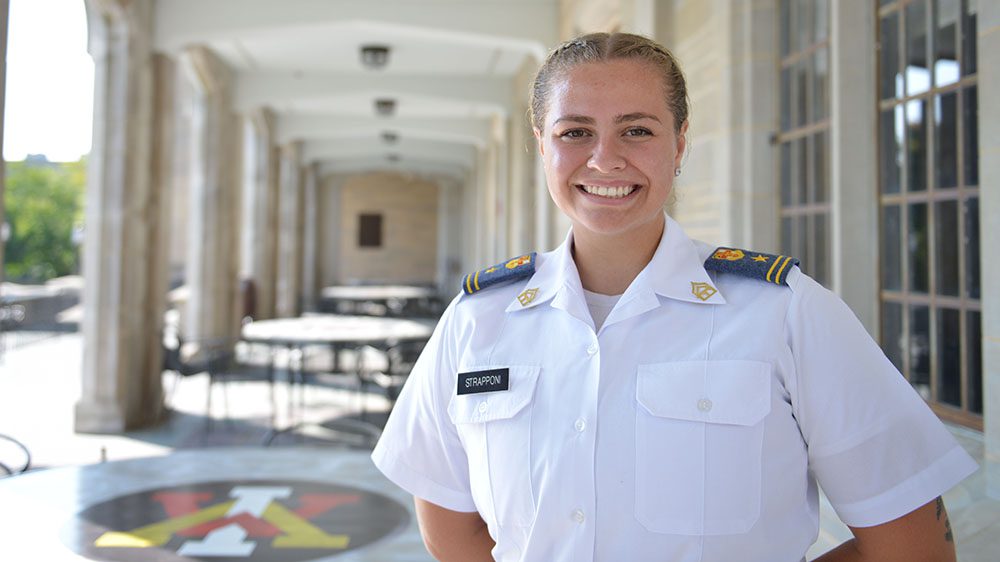Strapponi ’26: Inside the Secure World of Cybersecurity with Joint Special Operations Command


A base inside of a base is where Cadet Amber Strapponi ’26 spent nearly a month of her summer. With coding, cybersecurity, and high-level clearances, she experienced something new to her.
Strapponi, a computer science major with a concentration in cybersecurity, undertook an internship with the Joint Special Operations Command, a technical unit for the United States Special Operations Command. She was stationed at Fort Liberty in North Carolina for 28 days. She and Dominick Olhava, a cadet from the University of Northern Iowa, were the first cadet interns JSOC has ever had.
No outside phones, computers, or technology were allowed. Strapponi said she was working alongside those with high-level security clearances. She spent her days focused on security policies on their platform development team and strengthening the security posture of ARK, their custom-built Kubernetes platform. Kubernetes is Google’s open-sourced software for automating the deployment, scaling, and management of cloud-based applications.
USSOCOM is a unified combatant command within the Department of Defense that oversees the special operations capabilities of the U.S. Armed Forces. The JSOC prepares assigned, attached, and augmentation forces and conducts special operations against threats to protect the homeland and U.S. interests abroad.
Through her internship, Strapponi was able to deepen her skills in new coding platforms she’d never touched before. “It was the coolest thing I’ve ever done,” she said. “There’s a lot of it I can’t talk about because it was under clearance, but I got to program security policies that will be used on their custom platform. These policies will be used across all JSOC. It’s very cool because I can say that I got to help on that project.”
She found out about the internship through VMI’s Army ROTC department. There was a list of different opportunities, and JSOC stood out to Strapponi. She had previously worked on a project with the VMI Cyber Defense Lab on an electroencephalogram wheelchair. The skills she gained from that project can be applied to other zero-day technologies, which are security flaws in software or hardware unknown to the software provider and exploited by hackers before a fix is available.
Strapponi said the internship was unlike anything she’d ever experienced. One takeaway was being able to see one of the largest Faraday cages, an enclosure used to block some electromagnetic fields. “It’s like a zero room. Imagine this room, but the inside has spiky foam, and the outside it’s metal, so nothing inside exists outside. All the technology in there, it doesn’t exist outside of that room, which is really cool,” she said.
One of her favorite parts of the internship was seeing the server room on base. “I’m pretty sure they had everything that has ever existed in there. Just seeing everything they had, probably billions and billions of dollars worth of technology,” she said.
The bonds she made with fellow interns from other senior military colleges were also meaningful. “Walking around post, we were finding all the other cadets. We organized a cadet taco night,” she said. “It’s cool to kind of get everybody together.”
She hopes the experience she gained at her internship will allow her to apply to a unit similar to it once she graduates and commissions into the U.S. Army. She’s even able to come back, potentially next summer, to do another internship. “I would say this internship has put me ahead in life and even at VMI in general,” she said.
It allowed her to gain an extensive amount of practical experience she could apply later down the road. “This was on a platform I’d never even heard of, in a coding language I had never even used, so I was learning. It was just awesome,” she said. “I’ve never been in a true cybersecurity lab. I wasn’t even familiar with a lot of the current technologies used, especially from a military standpoint. We’re at the point now we can connect to the internet without actually having a connection to the internet.”
Editor's Note: Story originally published by Virginia Military Institute.